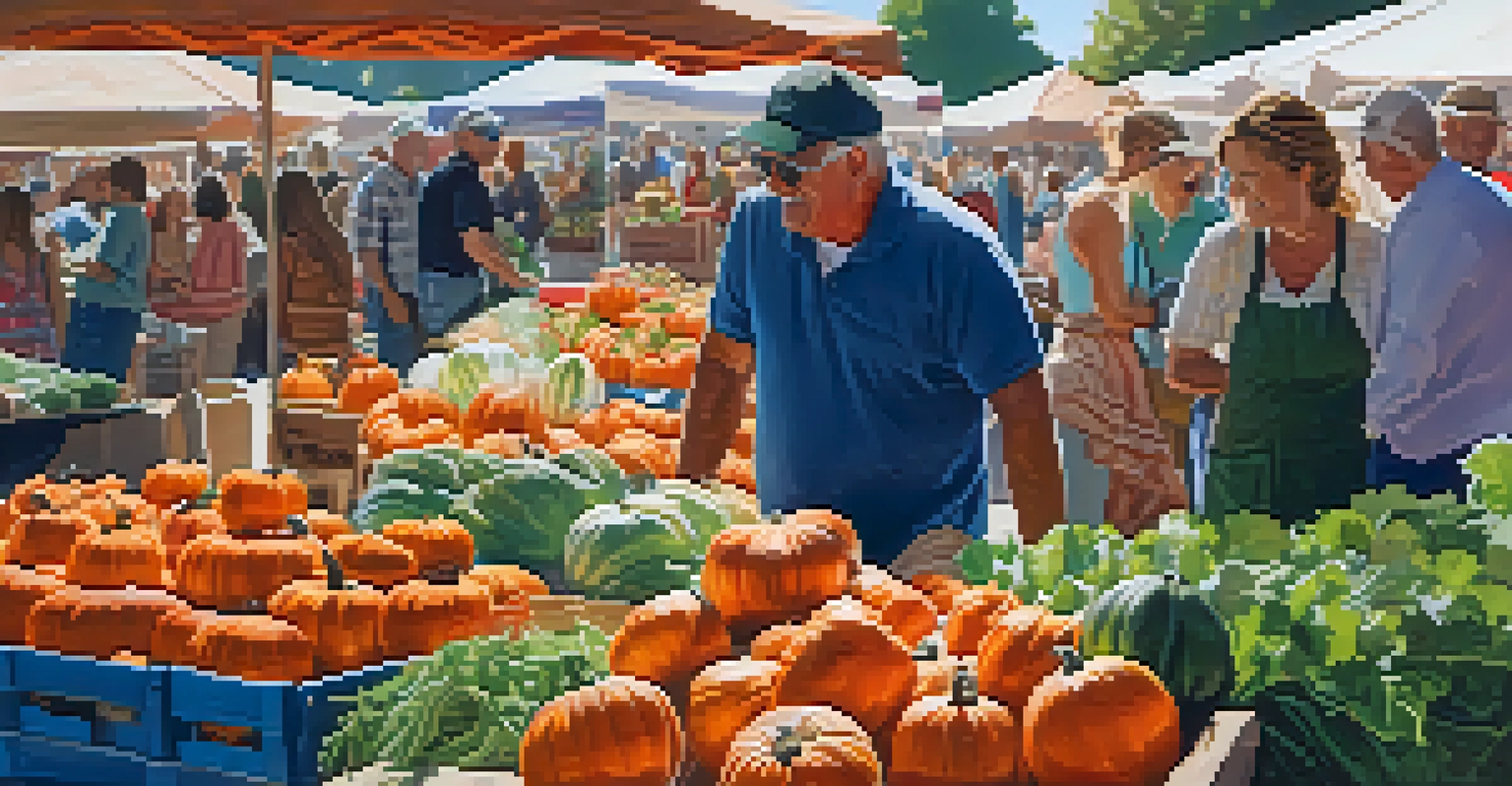Illinois Agricultural Exports: Boosting the Local Economy

Overview of Illinois' Agricultural Exports Landscape
Illinois is a powerhouse in agricultural production, consistently ranking among the top states in the U.S. for exports. The state's fertile land and favorable climate allow for a diverse array of crops, from corn and soybeans to livestock. In 2022, Illinois agricultural exports reached a staggering $9 billion, highlighting the importance of this sector to the local economy.
Agriculture is the backbone of our economy.
These exports not only contribute significantly to the state’s GDP but also create thousands of jobs within farming, processing, and transportation sectors. The ripple effect of agricultural success extends to local businesses, including suppliers and retailers who benefit from increased demand. As a result, the agriculture industry acts as a critical pillar supporting Illinois' economy.
With global markets continuously evolving, Illinois farmers are adapting by focusing on quality and sustainability. This commitment helps them meet international standards, making their products highly sought after. In essence, the agricultural export sector is not just about food; it represents a vital link to economic stability and growth.
Key Products Driving Illinois Agricultural Exports
Corn and soybeans dominate Illinois agricultural exports, together accounting for a significant portion of total export value. These crops are not only essential for animal feed but also play a crucial role in biofuels and other products. With global demand for these staples on the rise, Illinois farmers are well-positioned to meet and exceed market needs.

In addition to grains, Illinois also exports a variety of livestock and dairy products, showcasing the state's diverse agricultural capabilities. This includes everything from pork and beef to cheese and milk, which are increasingly popular in international markets. Such variety ensures that Illinois remains competitive and relevant in the global economy.
Illinois Exports: Economic Powerhouse
Illinois agricultural exports reached $9 billion in 2022, significantly contributing to the state's economy and job creation.
Moreover, specialty crops like pumpkins and organic produce are gaining traction, appealing to niche markets that prioritize quality and sustainability. This diversification allows farmers to explore new opportunities and reduce the risks associated with relying solely on traditional crops. Ultimately, these key products are instrumental in shaping the state's export landscape.
Impact of Agricultural Exports on Local Communities
Agricultural exports have a profound impact on local communities throughout Illinois. The money generated from these exports circulates within the community, boosting local businesses such as feed suppliers, equipment dealers, and grocery stores. This financial influx helps create a robust local economy that benefits everyone.
Sustainability is not a goal to be reached, but a way of life.
Furthermore, the agricultural sector often supports community initiatives, including schools, healthcare, and infrastructure projects. For instance, many farmers contribute to local charities and educational programs, fostering a sense of community and shared responsibility. This interconnectedness highlights how agricultural success translates to broader societal benefits.
As the agricultural export market grows, so does the potential for innovation and entrepreneurship within local communities. New ag-tech startups and sustainable farming practices are emerging, aimed at enhancing productivity and environmental stewardship. This not only strengthens the local economy but also positions Illinois as a leader in agricultural innovation.
Challenges Facing Illinois Agricultural Exports
Despite its successes, Illinois agriculture faces several challenges that could affect export growth. Climate change is a pressing issue, leading to unpredictable weather patterns that can disrupt crop yields. Farmers must adapt to these changes to maintain their competitive edge in the global market.
Trade policies and international relations also play a significant role in shaping agricultural exports. Tariffs and trade agreements can directly impact the profitability of Illinois products abroad. Therefore, staying informed about global trade dynamics is crucial for farmers and stakeholders alike.
Diverse Products Fueling Growth
Key exports like corn, soybeans, and livestock showcase Illinois' agricultural diversity, positioning it competitively in global markets.
Additionally, labor shortages pose a significant challenge, as many agricultural jobs are demanding and often go unfilled. Attracting a skilled workforce is essential for maintaining productivity and ensuring the continuation of high-quality exports. Addressing these challenges will be vital for sustaining the growth of Illinois agricultural exports.
Role of Technology in Enhancing Export Efficiency
Technology plays a critical role in improving the efficiency and quality of agricultural exports from Illinois. Precision farming, for example, utilizes data and analytics to optimize crop production. This innovative approach allows farmers to make informed decisions, minimizing waste and maximizing yields.
Additionally, advancements in logistics and supply chain management streamline the export process, ensuring that products reach international markets quickly and in optimal condition. From transportation tracking systems to improved packaging techniques, technology is making it easier for Illinois farmers to compete globally.
These technological innovations also contribute to sustainability efforts, reducing the environmental impact of farming practices. By utilizing resources more efficiently, farmers can produce high-quality goods while preserving the land for future generations. Ultimately, embracing technology is essential for maintaining Illinois' position as a leader in agricultural exports.
Future Trends in Illinois Agricultural Exports
Looking ahead, several trends are likely to shape the future of Illinois agricultural exports. One significant trend is the increasing consumer demand for organic and sustainably produced products. As more people seek healthier and more environmentally-friendly options, Illinois farmers are adapting to meet these evolving preferences.
Another trend is the shift towards value-added products, where raw agricultural materials are processed into higher-value goods. This can include everything from specialty grains to artisanal cheeses, which can command higher prices in export markets. By diversifying their offerings, Illinois farmers can enhance their profitability and resilience.
Challenges and Innovations Ahead
Despite facing challenges like climate change and labor shortages, technology and sustainable practices are paving the way for future growth in agricultural exports.
Finally, the integration of more sustainable practices in agriculture is becoming a focal point for future growth. This includes efforts to reduce carbon footprints and promote biodiversity. As the world becomes more environmentally conscious, Illinois agricultural exports that prioritize sustainability will likely gain increased market access and consumer support.
Conclusion: The Importance of Supporting Agricultural Exports
In conclusion, Illinois agricultural exports are a vital component of the state’s economy, providing jobs, supporting local communities, and contributing significantly to GDP. As the landscape continues to evolve, it is essential to support policies and initiatives that bolster this crucial sector. Investing in technology, education, and infrastructure will ensure that Illinois remains competitive on the global stage.
Furthermore, consumer awareness and preference for local and sustainable products can drive demand for Illinois agricultural exports. By choosing locally sourced products, consumers play a role in supporting their local economy and farmers. This mutually beneficial relationship creates a stronger, more resilient agricultural sector.

Ultimately, the future of Illinois agricultural exports looks promising, but it requires collective effort from farmers, policymakers, and consumers alike. Together, they can build a robust agricultural economy that not only thrives but also enriches the fabric of local communities.